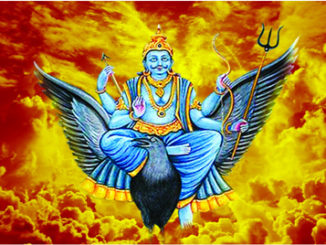The Upanishads form the core of Indian philosophy. They are an amazing collection of writings from original oral transmissions, which have been aptly described by Shri Aurobindo as “the supreme work of the Indian mind”. It is here that we find all the fundamental teachings that are central to Hinduism —the concepts of ‘karma’ (action), ‘samsara’ (reincarnation), ‘moksha’ (nirvana), the ‘atman’ (soul), and the ‘Brahman’ (Absolute Almighty). They also set forth the prime Vedic doctrines of self-realization, yoga and meditation. The Upanishads are summits of thought on mankind and the universe, designed to push human ideas to their very limit and beyond. They give us both spiritual vision and philosophical argument, and it is by a strictly personal effort that one can reach the truth.
Meaning of ‘Upanishad’
The term ‘Upanishad’ literally means, “sitting down near” or “sitting close to”, and implies listening closely to the mystic doctrines of a guru or a spiritual teacher, who has cognized the fundamental truths of the universe. It points to a period in time when groups of pupils sat near the teacher and learnt from him the secret teachings in the quietude of forest ‘ashrams’ or hermitages. In another sense of the term, ‘Upanishad’ means ‘brahma-knowledge’ by which ignorance is annihilated. Some other possible meanings of the compound word ‘Upanishad’ are “placing side by side” (equivalence or correlation), a “near approach” (to the Absolute Being), “secret wisdom” or even “sitting near the enlightened”.
Time of Composition
Historians and Indologists have put the date of composition of the Upanishads from around 800 – 400 B.C., though many of the verse versions may have been written much later. In fact, they were written over a very long period of time and do not represent a coherent body of information or one particular system of belief. However, there is a commonality of thought and approach.
The Main Books
Although there are more than 200 Upanishads, only thirteen have been identified out as presenting the core teachings. They are the Chandogya, Kena, Aitareya, Kaushitaki, Katha, Mundaka, Taittriyaka, Brihadaranyaka, Svetasvatara, Isa, Prasna, Mandukya and the Maitri Upanishads. One of the oldest and longest of the Upanishads, the Brihadaranyaka says: “From the unreal lead me to the real! From darkness lead me to light!
From death lead me to immortality!” The crux of the Upanishads is that this can be achieved by meditating with the awareness that one’s soul (‘atman’) is one with all things, and that ‘one’ is ‘Brahman’, which becomes the ‘all’.
Who wrote the Upanishads?
The authors of the Upanishads were many, but they were not solely from the priestly caste. They were poets prone to flashes of spiritual wisdom, and their aim was to guide a few chosen pupils to the point of liberation, which they themselves had attained. According to some scholars, the main figure in the Upanishads is Yajnavalkya, the great sage who propounded the doctrine of ‘neti-neti’, the view that “truth can be found only through the negation of all thoughts about it”. Other important Upanishadic sages are Uddalaka Aruni, Shwetaketu, Shandilya, Aitareya, Pippalada, Sanat Kumara. Many earlier Vedic teachers like Manu, Brihaspati, Ayasya and Narada are also found in the Upanishads.





Be the first to comment